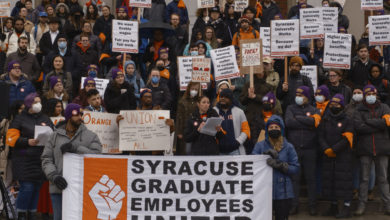On Dec. 17, six City University of New York students filed a
lawsuit to stop an impending tuition hike. The plaintiffs in the lawsuit
against CUNY Board of Trustees include Frances Villar, Dwight Peters,
Christian Peruyero, Lamont Oyewale Badru and Anthony Hang.
Villar—who is also Executive Vice President of Lehman’s Student
Government and a member of CUNY’s University Student Senate—sat down
with Liberation to discuss the lawsuit and the potential for a revived
student movement.
1.What is the nature of the lawsuit?
The lawsuit against the City University of New York Board of Trustees
requests an injunction to counter parts of the illegal 7 percent
tuition hike. I say illegal because under the state’s education laws, it
is illegal to propose an increase outside the state budget.
At
its November meeting, the Board of Trustees increased tuition 5 percent
for Spring 2011. It further raised the tuition 2 percent effective Fall
2011, and also gave power to the Chancellor to increase it an extra 3
percent. Our lawsuit challenges these last two Board acts.
2. What has happened recently at CUNY with respect to tuition hikes or cutbacks?
CUNY
is becoming more and more like a private institution, where the burden
of education costs falls on the students. Since 2002, tuition has gone
up 44 percent. Keep in mind that 38 percent of CUNY students come from
families with household incomes of less than $20,000. So over time they
are shutting out these poor and working-class students, who are
disproportionately people of color.
To make matters worse, state
and city assistance has also been cut. While the state has a Tuition
Assistance Program, part-time students are ineligible, and the rules and
regulations make it difficult to access.
In addition to the
tuition hikes, the Board of Trustees is trying to increase entrance
requirements, even for the community colleges. This is an attack at the
open admissions mission of CUNY and the gains made in favor of access
for Black and Latino students since 1968.
3. So now that
they have been challenged by the lawsuit, how has the administration
reacted? Have they tried to communicate with you directly?
They
have not communicated with me directly. The administration of course
has a huge team of lawyers to defeat the lawsuit and make sure the
tuition hike goes through. But they have also met and arranged meetings
with other members of the student government to discuss why the tuition
increase is “so important” to CUNY.
I think it’s clear that they
are scared of students rising up. They know what happened here in the
60s when students like us were fighting to open up admissions. They know
about how students fought to defend Hostos Community College. They
remember the mass rallies and campus takeovers in the 1980s and 90s.
That’s what they are afraid of.
4. The student movement
against education cuts has gone up and down quite a bit in the last two
years. How do you account for this, and as a student activist, how do
you see the CUNY struggle moving forward?
CUNY’s history
is one of struggle, of students fighting to expand the university
system, and make it fulfill its historic mission—which is to serve poor
and working-class communities.
Of course, the student movement
goes up and down. We have some particular difficulties in that there’s
such a high turnover, so it’s harder to build continuity from one group
of students to the next. Many students aren’t aware of that long history
of struggle to expand CUNY, and so they think there’s nothing we can
do.
The majority of students in CUNY are poor and working class,
so we are more bombarded with personal and survival issues. We have a
lot of family obligations. There are a huge number of immigrant students
too—about 45 percent of CUNY students speak a native language other
than English—and many are afraid that they will lose their access to
higher education if they challenge the cuts.
Despite these
obstacles, we are doing everything we can to revive the student
movement. This tuition increase is connected to the overall struggle
that’s going to heat up against cutbacks and layoffs, as well as the
privatization of education. Just look at what’s happened recently in
Britain, France and Greece. Students have been out in front saying “no”
to all the cutbacks that are supposed to be inevitable.
Young
working-class students see a job market that’s not getting better. We’ve
been told our whole lives just to apply ourselves, work hard and it
will pay off down the line. Right now people are frustrated that the
system’s not fulfilling its side of the deal. It’s our job as activists
to turn that frustration into action.
5. How does the lawsuit fit into that perspective?
The
lawsuit is just a small step—one way to organize and show students that
we are not powerless if we stick together. Of course we want the
lawsuit to succeed, and we think it should, but the courts are not
ultimately where working-class students have our strength. History has
proven time and again that you need a political strategy, an organizing
strategy, a movement—not just a legal strategy in order to affect
meaningful change.
We hope the lawsuit will be one step in
empowering the hundreds of thousands of CUNY students to mobilize and
defend what is ours.
6. If people want to support the lawsuit, or get involved with that movement, what should they do?
We
need to get organized. When we go back to school this semester, we need
to go to our friends, and all the clubs, tell them about the lawsuit
and ask them to get involved. Ask groups to hold meetings and forums
about the tuition hikes. Pass out flyers. Students are always busy—and
clubs have their own activities—but this affects all of us. If we don’t
do anything now, this trend towards privatization will only increase.
Anyone interested should also email us at [email protected] so
we can coordinate, and share experiences and resources. Even if you’ve
never been an activist before, this is a time you need to become one,
and you can be.






